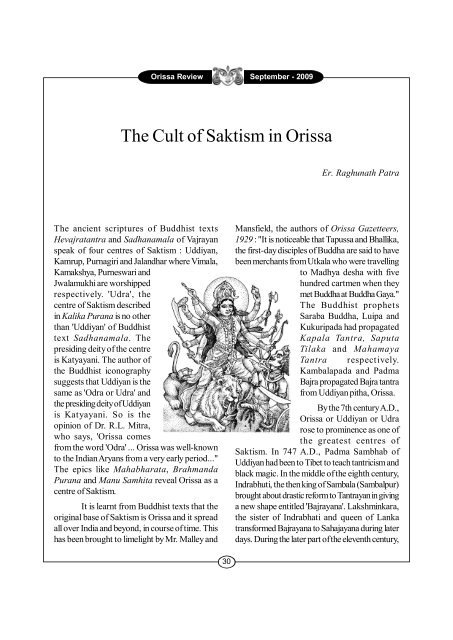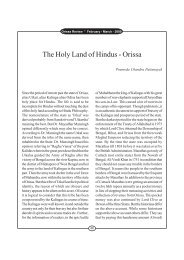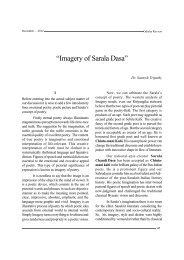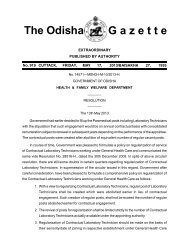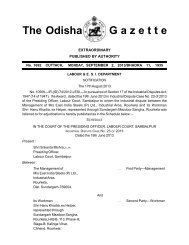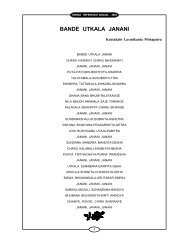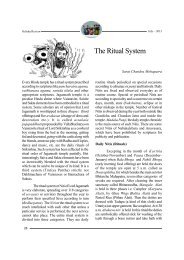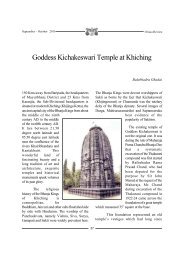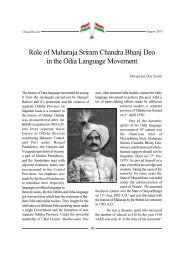The Cult of Saktism in Orissa - Government of Orissa
The Cult of Saktism in Orissa - Government of Orissa
The Cult of Saktism in Orissa - Government of Orissa
Create successful ePaper yourself
Turn your PDF publications into a flip-book with our unique Google optimized e-Paper software.
<strong>Orissa</strong> Review September - 2009<br />
<strong>The</strong> <strong>Cult</strong> <strong>of</strong> <strong>Saktism</strong> <strong>in</strong> <strong>Orissa</strong><br />
<strong>The</strong> ancient scriptures <strong>of</strong> Buddhist texts<br />
Hevajratantra and Sadhanamala <strong>of</strong> Vajrayan<br />
speak <strong>of</strong> four centres <strong>of</strong> <strong>Saktism</strong> : Uddiyan,<br />
Kamrup, Purnagiri and Jalandhar where Vimala,<br />
Kamakshya, Purneswari and<br />
Jwalamukhi are worshipped<br />
respectively. 'Udra', the<br />
centre <strong>of</strong> <strong>Saktism</strong> described<br />
<strong>in</strong> Kalika Purana is no other<br />
than 'Uddiyan' <strong>of</strong> Buddhist<br />
text Sadhanamala. <strong>The</strong><br />
presid<strong>in</strong>g deity <strong>of</strong> the centre<br />
is Katyayani. <strong>The</strong> author <strong>of</strong><br />
the Buddhist iconography<br />
suggests that Uddiyan is the<br />
same as 'Odra or Udra' and<br />
the presid<strong>in</strong>g deity <strong>of</strong> Uddiyan<br />
is Katyayani. So is the<br />
op<strong>in</strong>ion <strong>of</strong> Dr. R.L. Mitra,<br />
who says, '<strong>Orissa</strong> comes<br />
from the word 'Odra' ... <strong>Orissa</strong> was well-known<br />
to the Indian Aryans from a very early period..."<br />
<strong>The</strong> epics like Mahabharata, Brahmanda<br />
Purana and Manu Samhita reveal <strong>Orissa</strong> as a<br />
centre <strong>of</strong> <strong>Saktism</strong>.<br />
It is learnt from Buddhist texts that the<br />
orig<strong>in</strong>al base <strong>of</strong> <strong>Saktism</strong> is <strong>Orissa</strong> and it spread<br />
all over India and beyond, <strong>in</strong> course <strong>of</strong> time. This<br />
has been brought to limelight by Mr. Malley and<br />
30<br />
Er. Raghunath Patra<br />
Mansfield, the authors <strong>of</strong> <strong>Orissa</strong> Gazetteers,<br />
1929 : "It is noticeable that Tapussa and Bhallika,<br />
the first-day disciples <strong>of</strong> Buddha are said to have<br />
been merchants from Utkala who were travell<strong>in</strong>g<br />
to Madhya desha with five<br />
hundred cartmen when they<br />
met Buddha at Buddha Gaya."<br />
<strong>The</strong> Buddhist prophets<br />
Saraba Buddha, Luipa and<br />
Kukuripada had propagated<br />
Kapala Tantra, Saputa<br />
Tilaka and Mahamaya<br />
Tantra respectively.<br />
Kambalapada and Padma<br />
Bajra propagated Bajra tantra<br />
from Uddiyan pitha, <strong>Orissa</strong>.<br />
By the 7th century A.D.,<br />
<strong>Orissa</strong> or Uddiyan or Udra<br />
rose to prom<strong>in</strong>ence as one <strong>of</strong><br />
the greatest centres <strong>of</strong><br />
<strong>Saktism</strong>. In 747 A.D., Padma Sambhab <strong>of</strong><br />
Uddiyan had been to Tibet to teach tantricism and<br />
black magic. In the middle <strong>of</strong> the eighth century,<br />
Indrabhuti, the then k<strong>in</strong>g <strong>of</strong> Sambala (Sambalpur)<br />
brought about drastic reform to Tantrayan <strong>in</strong> giv<strong>in</strong>g<br />
a new shape entitled 'Bajrayana'. Lakshm<strong>in</strong>kara,<br />
the sister <strong>of</strong> Indrabhati and queen <strong>of</strong> Lanka<br />
transformed Bajrayana to Sahajayana dur<strong>in</strong>g later<br />
days. Dur<strong>in</strong>g the later part <strong>of</strong> the eleventh century,
the celebrated tantric women Nitei Dhobani and<br />
Pitei Sauruni were there <strong>in</strong> Sapta Matrika pitha<br />
<strong>of</strong> Puri at Markandeswar Sahi. <strong>The</strong>y were<br />
worshippers <strong>of</strong> Sapta Matrika and venerat<strong>in</strong>g<br />
Lord Jagannath and Goddess Vimala as Vairaba<br />
and Vairabi respectively.<br />
Some important scriptures available <strong>in</strong><br />
Tibet reveal that Indrabhuti was the k<strong>in</strong>g <strong>of</strong><br />
Uddiyan and <strong>in</strong> the prelim<strong>in</strong>ary prayer <strong>of</strong> 'Jnana<br />
Sidhi', he had the vision <strong>of</strong> Lord Jagannath as<br />
Buddhist lord. Padma Sambhab, the adopted son<br />
<strong>of</strong> Indrabhuti, with the help <strong>of</strong> his wife Mandaraba,<br />
had achieved accomplishment <strong>in</strong> Sahaja-Yoga.<br />
Some <strong>of</strong> the antique scriptures <strong>of</strong> Nepal suggest<br />
that few centuries later, Lord Buddha <strong>in</strong>carnated<br />
himself as Padma Sambhab <strong>in</strong> Uddiyan. In the<br />
second century, Ptolemy, the geographer, stated<br />
that Sambal is situated <strong>in</strong> the bas<strong>in</strong> <strong>of</strong> the river<br />
Manad. Sambal is no other than the present<br />
Sambalpur and Manad, the river Mahanadi. On<br />
the basis <strong>of</strong> the old copper-plates and<br />
archaeological rema<strong>in</strong>s, it is argued that Lanka<br />
was no other than the present Sonepur <strong>of</strong> <strong>Orissa</strong>.<br />
It may easily be shown that Uddiyan or<br />
<strong>Orissa</strong> is the mother - centre <strong>of</strong> <strong>Saktism</strong> where<br />
Bhairaba is Lord Jagannath and Bhairabi, Vimala.<br />
<strong>The</strong>re is sufficient mention <strong>in</strong> support <strong>of</strong> this <strong>in</strong><br />
Kalika Purana and Devi Bhagavata. Vimala<br />
is one <strong>of</strong> the names <strong>of</strong> goddess Durga <strong>in</strong> Devi<br />
Bhagavat and Biswa Saratantra.<br />
Dur<strong>in</strong>g marriage - ritual <strong>of</strong> Rukm<strong>in</strong>i with<br />
Lord Krishna <strong>in</strong> Jagannath temple, Goddess<br />
Rukm<strong>in</strong>i goes to the temple <strong>of</strong> Vimala for worship<br />
to get Lord Krishna as her husband. <strong>The</strong>re Vimala<br />
is prayed as Katyayani by Rukm<strong>in</strong>i.<br />
Hence Uddiyan or <strong>Orissa</strong> is the mother<br />
centre <strong>of</strong> <strong>Saktism</strong> and Vimala (Katyayani) is the<br />
deity <strong>of</strong> Uddiyan pitha, encircled by Mother<br />
goddesses, namely, Viraja at Jajpur, Sarala at<br />
Jhankad, Mangala at Kakatpur, Bhagavati at<br />
<strong>Orissa</strong> Review September - 2009<br />
31<br />
Banpur, Harachandi at Puri, Ramachandi at<br />
Konark, Charchika at Banki, Bag Devi at Kulad,<br />
Stambeswari at Aska and Sonepur, H<strong>in</strong>gula at<br />
Talcher, Narayani at Khalikote, Tara Tareni <strong>in</strong><br />
Ganjam, Bhattarika at Badamba, Barunei at<br />
Khurda, Chandi at Cuttack, Sapta Matrika at<br />
Puri, Jajpur, Belakhandi, Titilagarh, Khich<strong>in</strong>g,<br />
Dharmasala, Kundeswar and Seragarh and 64 -<br />
Yog<strong>in</strong>is at Hirapur and Ranipur - Jhariyal and<br />
Samaleswari at Sambalpur and many others.<br />
<strong>The</strong>re is a nice legend <strong>in</strong> connection with<br />
the <strong>in</strong>ception <strong>of</strong>Sakta - pithas all over the country<br />
and beyond. Dakshyaprajapati, the father <strong>of</strong><br />
goddess Sati, did not <strong>in</strong>vite his son-<strong>in</strong>-law Lord<br />
Siva to his sacrificial rites. Sati went to the function<br />
un<strong>in</strong>vited aga<strong>in</strong>st the will <strong>of</strong> Lord Siva.<br />
Dakshyaprajapati passed filthy comments on<br />
Lord Siva <strong>in</strong> presence <strong>of</strong> all div<strong>in</strong>ities. Sati could<br />
not tolerate censure <strong>of</strong> her husband and threw<br />
herself to the sacred fires and committed suicide.<br />
Lord Shankar, with pangs <strong>of</strong> separation, moved<br />
her and there, carry<strong>in</strong>g the dead body <strong>of</strong> his<br />
beloved wife on his shoulder. For the welfare <strong>of</strong><br />
the world, Lord Visnu directed his missile<br />
(Sudarshan Chakra) to cut the dead body <strong>of</strong> Sati<br />
<strong>in</strong>to pieces without the knowledge <strong>of</strong> Shankar.<br />
Innumerable Sakta-pithas were erected from<br />
every fragment <strong>of</strong> the body <strong>of</strong> Sati which fell to<br />
the ground. It is said that the dead body was cut<br />
<strong>in</strong>to pieces. Accord<strong>in</strong>g to Devi Bhagvat, 108<br />
centres <strong>of</strong> <strong>Saktism</strong> were erected out <strong>of</strong> 108<br />
fragments. From the navel-chord was the Viraja<br />
- pitha <strong>of</strong> Jajpur and from the tongue <strong>of</strong> goddess<br />
Sati, Vimala - pitha at Puri, as mentioned <strong>in</strong><br />
Uddisa tantra.<br />
THE SHRINES<br />
Vimala :<br />
<strong>The</strong> temple <strong>of</strong> Vimala is situated <strong>in</strong> the<br />
South-West corner <strong>of</strong> the court-yard <strong>of</strong> Lord<br />
Jagannath temple at Puri. Mother goddess is <strong>in</strong> a
stand<strong>in</strong>g posture with four arms, hold<strong>in</strong>g garland<br />
<strong>of</strong> beads, noose, pitcher <strong>of</strong> nectar and <strong>in</strong> Japamudra.<br />
She is worshipped <strong>in</strong> Bhubaneswari<br />
mantra except on 7th, 8th and 9th bright days <strong>of</strong><br />
the month <strong>of</strong> Asw<strong>in</strong>a when non-vegetarian food<br />
is <strong>of</strong>fered to Her.<br />
Vimala is described as Supreme<br />
Vaishnavi goddess who takes Kaibalya or<br />
Mahaprasad <strong>of</strong> Lord Jagannath as her only food<br />
unlike other goddesses <strong>in</strong> Jagannath temple. She<br />
goes to bed only after Lord Jgannath retires.<br />
Vimala is most closely associated with the rituals<br />
<strong>of</strong> Lord Jagannath compared to other goddesses<br />
<strong>in</strong> the temple. When goddess Lakshmi has her<br />
separate arrangement for cook<strong>in</strong>g other than<br />
Mahaprasad, Vimala takes Mahaprasad<br />
throughout the year except on 7th, 8th and 9th<br />
bright days <strong>of</strong> the month <strong>of</strong> Asw<strong>in</strong>a. Dur<strong>in</strong>g these<br />
days <strong>of</strong> Durga Puja, she is <strong>of</strong>fered two goats a<br />
day on each <strong>of</strong> the three days (total six goats) as<br />
sacrifice to Her due to the <strong>in</strong>fluence <strong>of</strong> 'Bamachar<br />
worship' <strong>of</strong> <strong>Saktism</strong> which seems to be a later<br />
<strong>in</strong>troduction. <strong>The</strong> sacrifice <strong>of</strong> goats to Mother<br />
goddess is done late <strong>in</strong> the night after Lord<br />
Jagannath goes to bed which clearly shows that<br />
the priests <strong>of</strong> Lord Jagannath do not co-operate<br />
with Bamachar worship <strong>of</strong> Vimala and such<br />
worship is be<strong>in</strong>g performed by a few Bamachar<br />
worshippers <strong>in</strong> Vimala temple. <strong>The</strong> rituals <strong>of</strong> Lord<br />
Jagannath are based on Sudhachar only. <strong>The</strong><br />
domed ro<strong>of</strong> <strong>of</strong> Vimala with its <strong>in</strong>ner surface reveal<br />
the figures <strong>of</strong> Vaishnavism. Though Vimala, the<br />
first and foremost deity <strong>of</strong> Uddiyan (<strong>Orissa</strong>) has<br />
been described as Bhairabi and Lord Jagannath<br />
as Bhairaba, the Vaishnavites treat her as wife <strong>of</strong><br />
Lord Balabhadra.<br />
Out <strong>of</strong> sixteen days <strong>of</strong> Durga Puja <strong>in</strong> the<br />
month <strong>of</strong> Asw<strong>in</strong>, Goddess Vimala does not wear<br />
any specific attire on first and last four days.<br />
Dur<strong>in</strong>g the rest eleven days, she is adorned as<br />
<strong>Orissa</strong> Review September - 2009<br />
32<br />
Bhubaneswari, Bana Durga, Rajarajeswari,<br />
Ugratara, Matang<strong>in</strong>i, Bagala, Narayani,<br />
Simhabah<strong>in</strong>i, Jaya Durga, Shuli Durga and<br />
Harachandi respectively.<br />
From the 8th dark day to the new moonday<br />
<strong>of</strong> Asw<strong>in</strong> (eight days), Durga -Madhab<br />
(Durga and Madhab or Jagannath fastened<br />
together on a wooden platform) are seated on a<br />
cot <strong>in</strong> the Jagamohan <strong>of</strong> Vimala temple and from<br />
first bright day to n<strong>in</strong>th bright day take up on a<br />
journey to Narayani temple <strong>of</strong> Dolamandap Sahi<br />
on a chariot which is known as Sakta gundicha<br />
or Car Festival <strong>of</strong> Durga Madhab.<br />
Viraja :<br />
Viraja - tirtha on the sacred bank <strong>of</strong> river<br />
Baitarani found its celeberation dur<strong>in</strong>g<br />
Mahabharat days and commemorates ten Horse<br />
Sacrifices (Dasaswamedha Yajna), conducted by<br />
Lord Brahma <strong>in</strong> Puranic age and Yayati Keshari-<br />
I, the k<strong>in</strong>g <strong>of</strong> 10th century A.D. It has got its early<br />
name and fame as a Sakti-pitha <strong>in</strong> the Puranas<br />
like Visnu Purana, Brahma Purana, Kapila<br />
Samhita, Kubjika tantra, Jnanaranaba tantra<br />
and Brihannila tantra etc. It is said that the<br />
goddess emerged from the sacrificial fires <strong>of</strong> the<br />
Aswamedha Yajna.<br />
Viraja mostly rema<strong>in</strong>s clothed. She firmly<br />
holds the tail <strong>of</strong> buffalo-demon by her left hand<br />
and pierces it with a spear by the right. Image <strong>of</strong><br />
goddess with two hands dates back to 4th or 5th<br />
century A.D. It is one <strong>of</strong> the fifty-one dist<strong>in</strong>guished<br />
Sakti-shr<strong>in</strong>es <strong>of</strong> India, erected from the sacred<br />
navel - chord <strong>of</strong> goddess Sati. <strong>The</strong> n<strong>in</strong>e day -<br />
festival <strong>of</strong> Durga Puja is celebrated with great<br />
fanfare and on the fifth day <strong>of</strong> the function, the<br />
car festival <strong>of</strong> Viraja is celebrated by thousands<br />
<strong>of</strong> devotees from all around which is known as<br />
'Sakta-Gundicha'. Some are <strong>of</strong> op<strong>in</strong>ion that<br />
Viraja is no other than Prajna - Paramita <strong>of</strong><br />
Buddhism.
<strong>The</strong> goddess Viraja is clustered around<br />
with three Varahas, five Nrusimhas, seven<br />
Matrikas, eight Bhairabs, n<strong>in</strong>e Durgas, twelve<br />
Madhavas, twelve Ganeshas and one hundred and<br />
eight Rudras. Though the deity relates to 4th<br />
century A.D., the present sanctum is <strong>of</strong> 200 years<br />
old only. <strong>The</strong> place Jajpur and its suburbs are full<br />
<strong>of</strong> icons <strong>of</strong> Buddhism and Ja<strong>in</strong>ism such as<br />
Bodhisattvas, Dhyani Buddhas and Ja<strong>in</strong>a<br />
Tirthankars. Udayagiri, Ratnagiri, Lalitagiri and<br />
Alatigiri are four ancient Sakta centres <strong>in</strong> the<br />
suburbs, with Buddhist deities Tara, Heruka,<br />
Kurukula and Aparajita.<br />
Sarala<br />
Goddess Sarala <strong>of</strong> Jhankad, a village <strong>in</strong><br />
Jagats<strong>in</strong>ghpur district is be<strong>in</strong>g worshipped by<br />
people <strong>of</strong> <strong>Orissa</strong> as Goddess <strong>of</strong> Learn<strong>in</strong>g and<br />
wielder <strong>of</strong> powers as M<strong>in</strong>erva <strong>in</strong> Greek myth.<br />
Accord<strong>in</strong>g to a legend, Lord Parashuram, the<br />
<strong>in</strong>carnation <strong>of</strong> Lord Visnu ga<strong>in</strong>ed all wisdom and<br />
powers to conquer the whole world twenty one<br />
times, by ly<strong>in</strong>g <strong>in</strong> prostration to goddess Sarala,<br />
and so the place is also known as Parashuram<br />
Pitha.<br />
Goddess Sarala with her eight arms<br />
fought with the demon <strong>of</strong> beastly power, ignorance<br />
and lez<strong>in</strong>ess, Mahishasura, hold<strong>in</strong>g the gap<strong>in</strong>g<br />
mouth <strong>of</strong> the demon with one hand and with the<br />
other seven, she brandishes weapons and a gongbell.<br />
<strong>The</strong> lion, the Bahana or Vehicle <strong>of</strong> the<br />
goddess, attacked demon from right when she<br />
pressed the creature on the back with her mighty<br />
foot. Goddess Sarala has got some resemblance<br />
with image <strong>of</strong> Durga <strong>in</strong> Baital temple dat<strong>in</strong>g back<br />
to 8th century A.D. Sarala blessed Adikabi Sarala<br />
Das the epic poet <strong>of</strong> Odia Mahabharat. She<br />
bestowed grace on the illiterate Sarala Das to<br />
produce Odia Mahabharata a perennial source<br />
<strong>of</strong> illum<strong>in</strong>ation for scholars and the lovers <strong>of</strong> art<br />
and culture.<br />
<strong>Orissa</strong> Review September - 2009<br />
33<br />
<strong>The</strong> orig<strong>in</strong>al sanctum that stands <strong>in</strong> ru<strong>in</strong>s<br />
has given place to the present shr<strong>in</strong>e which is <strong>of</strong><br />
two hundred years old only. <strong>The</strong> festivals dur<strong>in</strong>g<br />
Dasahara, Raja Sankranti and Pana Sankranti are<br />
<strong>of</strong> special significance which draw millions <strong>of</strong><br />
people from all around.<br />
Mangala<br />
<strong>The</strong> banks <strong>of</strong> sacred river Prachi were<br />
once the sites for accomplishment <strong>of</strong> tantricism.<br />
It stretched from Kakatpur <strong>of</strong> Puri district to<br />
Phulnakhara <strong>of</strong> Cuttack district, clustered around<br />
by gods and goddesses <strong>of</strong> antiquities, rang<strong>in</strong>g<br />
from 2nd century A.D. to 11th century A.D.<br />
Goddess Mangala dates back to 9th<br />
century A.D. and the temple <strong>in</strong> which she is<br />
enshr<strong>in</strong>ed relates to 15th century A.D. <strong>The</strong> Div<strong>in</strong>e<br />
Mother seated on Lalitasan on a double lotus<br />
pedestal with her four arms, hold<strong>in</strong>g a full moon<br />
symbolis<strong>in</strong>g Dharma Chakra by her upper right<br />
hand, a bunch <strong>of</strong> lotus lends by left upper, a Japa<br />
mala (garland <strong>of</strong> beads) by lower right and Japa<br />
mudra <strong>in</strong> the left lower, looks graceful with her<br />
jewellery crown carved with super artistic<br />
ref<strong>in</strong>ement. <strong>The</strong> holy Mother has her special<br />
recognition among the devotees <strong>of</strong> <strong>Orissa</strong> because<br />
<strong>of</strong> her association with Lord Jagannath dur<strong>in</strong>g<br />
Nabakalebar (the renovation ceremony <strong>of</strong> the<br />
body) <strong>of</strong> Lord Jagannath. It is believed that<br />
Daitas, the Savara Sevakas <strong>of</strong> Lord Jagannath,<br />
pray for her direction when they set out on a<br />
journey to locate holy log (Daru) for the icon <strong>of</strong><br />
the Lord.<br />
Accord<strong>in</strong>g to some scholars, Mother<br />
Mangala was orig<strong>in</strong>ally Buddhist goddess Tara<br />
brought from Srilanka dur<strong>in</strong>g the days <strong>of</strong> maritime<br />
relationship between Kal<strong>in</strong>ga (<strong>Orissa</strong>) and<br />
Srilanka and was absorbed <strong>in</strong>to H<strong>in</strong>du pantheon<br />
later.<br />
<strong>The</strong> name <strong>of</strong> the place Kakatpur has its<br />
orig<strong>in</strong> from the name Kakati, the tutelary goddess
<strong>of</strong> the place. Some scholars believe that Mangala<br />
is no other than Kakatei. In the nearby village<br />
'Chourasi' goddess Varahi is worshipped. She has<br />
the face <strong>of</strong> a boar, pot bellied, hold<strong>in</strong>g a fish <strong>in</strong><br />
one hand and a cup <strong>in</strong> the others, and the image<br />
relates to 9th century A.D. Two armed goddess<br />
Mahisa Mard<strong>in</strong>i <strong>of</strong> Someswara temple at<br />
Kakatpur seems to be contemporary <strong>of</strong> Viraja at<br />
Jajpur. Besides, four armed goddess <strong>of</strong> Motia,<br />
six armed goddess <strong>of</strong> Astaranga, eight armed<br />
goddess <strong>of</strong> Amanakuda, ten armed goddess <strong>of</strong><br />
Lataharan, eight armed Chamunda <strong>of</strong> Angeswara<br />
temple and ten armed Chamunda <strong>of</strong> Mangala<br />
Temple at Kakatpur draw attention <strong>of</strong> scholars,<br />
archaeologists and historians.<br />
Bhagavati :<br />
<strong>The</strong> temple <strong>of</strong> Bhagavati is located on the<br />
river bank <strong>of</strong> Salia at Banpur <strong>of</strong> Puri district. It is<br />
about 300 years old. Goddess Bhagavati was<br />
tutelory deity <strong>of</strong> the demon - k<strong>in</strong>g Banasura, as<br />
the legend goes. Bhagavati was orig<strong>in</strong>ally<br />
worshhipped under a tree with the <strong>of</strong>fer<strong>in</strong>gs <strong>of</strong><br />
goat, buffalo and human be<strong>in</strong>gs. <strong>The</strong> present<br />
sanctum was constructed by one Sri Jagannath<br />
Harichandan, a k<strong>in</strong>g <strong>of</strong> Rathor dynasty whose<br />
royal court was adorned by the Oriya poet,<br />
Lokanath Bidyadhar, author <strong>of</strong> Chitrakala,<br />
Sarbanga Sundari, Padmavati Par<strong>in</strong>aya and<br />
Niladri Mahotsab etc. <strong>The</strong> k<strong>in</strong>g had allotted<br />
some landed property for the rituals <strong>of</strong> Bhagavati<br />
along with Chhatisa Niyog - Sevakas.<br />
<strong>The</strong> temple is built <strong>in</strong> three parts. <strong>The</strong> front<br />
chamber is Jagamohan and the second chamber<br />
is Natamandir where the mov<strong>in</strong>g deity "Vije<br />
Pratima' rema<strong>in</strong>s <strong>in</strong> the form <strong>of</strong> a log <strong>of</strong> timber<br />
known as 'Kathi Thakurani'. In the third chamber<br />
'Biman', dwells Bhagavati with eight arms. <strong>The</strong>re<br />
are associate gods and goddess namely Ganesh<br />
<strong>in</strong> the South, Durga <strong>in</strong> the East and Bhubaneswari<br />
<strong>Orissa</strong> Review September - 2009<br />
34<br />
<strong>in</strong> the North. In the courtyard <strong>of</strong> the temple, there<br />
are goddesses like Palakasuni, Virajai etc.<br />
Goddess Bhagavati orig<strong>in</strong>ally was <strong>of</strong><br />
terrible nature, and as such a metal belt was kept<br />
embedded around the month. <strong>The</strong> mov<strong>in</strong>g form<br />
<strong>of</strong> Bhagavati 'Kathi Thakurani' jo<strong>in</strong>s <strong>in</strong> all the<br />
rituals except <strong>in</strong> Dasahara when Kanak Durga<br />
jo<strong>in</strong>s.<br />
'Bali Jena' is one <strong>of</strong> the Sevakas <strong>of</strong><br />
Bhagavati who enacts the role <strong>of</strong> human sacrifice<br />
fall<strong>in</strong>g senseless to the ground for some hours<br />
when his wife acts as widow. This signifies that <strong>in</strong><br />
the older days, there prevailed the custom <strong>of</strong><br />
human sacrifice to the goddess 'Bhagavati'. A good<br />
number <strong>of</strong> festivals are observed round the year<br />
namely Chandan Yatra, Savitri Amabasya, Sitala<br />
Sasti, Chitalagi Amabasya and Durga Puja etc.<br />
Harachandi :<br />
<strong>The</strong> temple <strong>of</strong> Harachandi is situated on<br />
a sand dune near the mouth <strong>of</strong> the lake Chilika<br />
jo<strong>in</strong><strong>in</strong>g with the Bay <strong>of</strong> Bengal. the Div<strong>in</strong>e couple<br />
Chandra Sekhar and Harachandi are worshipped<br />
here. <strong>The</strong> deity is carved on a black granite with<br />
skilled art and ref<strong>in</strong>ement. To the op<strong>in</strong>ion <strong>of</strong> some<br />
scholars, Goddess Harachandi seems to be<br />
contemporary <strong>of</strong> Mangala <strong>of</strong> Kakatpur and<br />
Sarala <strong>of</strong> Jhankad.<br />
<strong>The</strong> temple <strong>of</strong> Harachandi was<br />
constructed by one Sri Rama Chandra Dev, thethen<br />
Gajapati k<strong>in</strong>g <strong>of</strong> <strong>Orissa</strong>, on the advice <strong>of</strong> a<br />
tantric Sadhak named Tratak Kapalika who<br />
attended full accomplishment by long prostration<br />
to goddess Harachandi. Now, dur<strong>in</strong>g Durga Puja<br />
a betel - nut is <strong>of</strong>fered to the goddess <strong>in</strong><br />
commemoration <strong>of</strong> the memory <strong>of</strong> the Gajapati<br />
and Mahaprasad <strong>of</strong> Lord Jagannath is brought<br />
daily from Jagannath temple, Puri for <strong>of</strong>fer<strong>in</strong>g to<br />
the Div<strong>in</strong>e Mother. Dur<strong>in</strong>g Durga Puja a goat is<br />
<strong>of</strong>fered by Gajapati for sacrifice to the goddess<br />
Harachandi.
Ramachandi :<br />
<strong>The</strong> temple <strong>of</strong> Ramachandi is located on<br />
a sand dune near the mouths <strong>of</strong> the rivers<br />
Kushabhadra and Dhanua, four miles away on<br />
the sea-side from Konark, <strong>in</strong> an isolated place.<br />
Previously the temple was not negotiable by any<br />
road with only sands and shrubs around but now<br />
a pucca road leads to the temple from Konark<br />
and Puri. <strong>The</strong> place is famous for picnic for the<br />
natural beauties around and cool breeze <strong>of</strong> the<br />
sea.<br />
<strong>The</strong> boat shaped ro<strong>of</strong> <strong>of</strong> the entrance hall<br />
<strong>of</strong> the temple is the only shelter for the people<br />
com<strong>in</strong>g over, for picnic or prostration to goddess<br />
Mother, <strong>in</strong> ra<strong>in</strong> and Sun. Mahisha Mard<strong>in</strong>i Durga<br />
Ramachandi sits <strong>in</strong> the temple fac<strong>in</strong>g North. Sri<br />
Krupas<strong>in</strong>dhu Mishra, the historian has described<br />
<strong>in</strong> his book 'Konark' that orig<strong>in</strong>ally Ramachandi<br />
was worshipped <strong>in</strong> South - West corner <strong>of</strong> the<br />
court-yard <strong>of</strong> Konark temple and later shifted to<br />
the present shr<strong>in</strong>e. This has been admitted by<br />
Pandit Nilakantha Das although Adikabi Sarala<br />
Das and Balaram Das differ <strong>in</strong> their op<strong>in</strong>ion.<br />
Banaparva <strong>of</strong> Sarala Mahabharatand<br />
Aranyak Parba <strong>of</strong> Jagamohan Ramayan speak<br />
<strong>of</strong> Lord Ramachandra's prostration to goddess<br />
Ramachandi before <strong>in</strong>vasion <strong>of</strong> Lanka.<br />
<strong>The</strong> deity outside the Western wall is <strong>of</strong><br />
archeological importance. Two and half feet high,<br />
three faced and eight armed goddess stands on a<br />
chariot driven by seven horses. In four arms she<br />
carries goad, noose, bow and arrow and other<br />
four arms are broken. <strong>The</strong> skilled art <strong>of</strong> Konark<br />
temple is reflected <strong>in</strong> this deity flanked by Ganesh<br />
and Barahas.<br />
Charchika :<br />
<strong>The</strong> temple <strong>of</strong> goddess Charchika is<br />
situated on a mounta<strong>in</strong> at Banki town <strong>of</strong> Cuttack<br />
district, by the side <strong>of</strong> the river Mahanadi and<br />
associated with Lord Parashuram who had long<br />
<strong>Orissa</strong> Review September - 2009<br />
35<br />
meditation before goddess Charchika to get rid<br />
<strong>of</strong> the s<strong>in</strong> <strong>of</strong> matricide. So the place is known as<br />
Parashuram pitha. A river named Renuka (the<br />
name <strong>of</strong> the mother <strong>of</strong> Parashuram) was flow<strong>in</strong>g<br />
by the side <strong>of</strong> the mounta<strong>in</strong> <strong>in</strong> the long past. One<br />
<strong>of</strong> the k<strong>in</strong>gs <strong>of</strong> Dhala dynasty had constructed<br />
this temple. Though the ma<strong>in</strong> temple is<br />
architecturally <strong>of</strong> no attraction, its front wooden<br />
pavilion preserves <strong>Orissa</strong>n antique art and<br />
architecture <strong>in</strong> wooden carv<strong>in</strong>g. <strong>The</strong> thickets<br />
encircl<strong>in</strong>g the temple have been replaced by a<br />
small town.<br />
<strong>The</strong> presid<strong>in</strong>g deity fixed to the back wall<br />
<strong>of</strong> sanctum - sanctorum has withered and a replica<br />
is kept <strong>in</strong> the central niche <strong>of</strong> the outer Southern<br />
wall <strong>of</strong> the ma<strong>in</strong> shr<strong>in</strong>e which may be well identified<br />
with a Chamunda stand<strong>in</strong>g on a dead body, fully<br />
undressed, with a garland <strong>of</strong> skull around her<br />
neck. Goddess Charchika with her eight hands<br />
displays sword, trident, snake, goad, garland <strong>of</strong><br />
beads, boon, damaru (small double faced drum)<br />
and severed head etc. Goddess Charchika does<br />
not come under goddess <strong>of</strong> Vaishnavism. She is<br />
Chamunda, for which non-vegetarian food is<br />
<strong>of</strong>fered daily. From iconographic and artistic po<strong>in</strong>t<br />
<strong>of</strong> view, she may be placed to Bhaumakara period<br />
<strong>of</strong> <strong>Orissa</strong>.<br />
<strong>The</strong>re are Pancha Mahadev and Sri<br />
Mangala <strong>in</strong>side the temple <strong>of</strong> Charchika. Pana<br />
Yatra, Jhamu Yatra, Durga Puja, Kumar<br />
Purnima, Basanti Puja and Dola Yatra are the<br />
important festivals where thousands <strong>of</strong> people<br />
swarm about. On eighth bright night <strong>of</strong> Durga<br />
Puja, a buffalo is <strong>of</strong>fered to goddess Mangala.<br />
On Kumar Purnima, Charchika is dressed up <strong>in</strong><br />
Kumari attire.<br />
Brahm<strong>in</strong> Sevakas were engaged <strong>in</strong> the<br />
worship <strong>of</strong> Goddess by the k<strong>in</strong>gs and landed<br />
property allotted to them to meet the expenses <strong>of</strong><br />
the rituals, round the year.
Bag Devi<br />
Bag Devi or Byaghra Devi is the tutelary<br />
deity <strong>of</strong> Bhanja dynasty <strong>of</strong> Southern <strong>Orissa</strong>,<br />
worshipped <strong>in</strong> Kulad fort <strong>of</strong> Ghumusar <strong>in</strong> Ganjam<br />
district. Orig<strong>in</strong>ally she was propitiated <strong>in</strong> one <strong>of</strong><br />
the caves <strong>of</strong> Bag Devi - mounta<strong>in</strong>, spread<strong>in</strong>g to<br />
the western side <strong>of</strong> the fort, on every Tuesday,<br />
untill she got enshr<strong>in</strong>ed <strong>in</strong> a temple constructed<br />
by late Dhananjaya Bhanja, grand-father <strong>of</strong> the<br />
great poet Upendra Bhanja.<br />
Eight armed goddess Bag Devi with bow<br />
and arrow sits on a tiger, press<strong>in</strong>g down a dead<br />
body. Ru<strong>in</strong>s <strong>of</strong> the palace are visible at a distance<br />
from the temple. Goddess Bag Devi is worshipped<br />
<strong>in</strong> both the temples on the top and bottom <strong>of</strong> the<br />
hill. <strong>The</strong> temple on the mounta<strong>in</strong> is known as 'Yoga<br />
Pitha' and at the bottom 'Bhoga Pitha' <strong>of</strong> goddess<br />
Bag Devi. On every Sankranti, Tuesdays <strong>of</strong> the<br />
month Chaitra and Durga Puja, the sanctum is<br />
crowded by people from all around. Dur<strong>in</strong>g<br />
Durga Puja goats are sacrificed to the Goddess.<br />
<strong>The</strong> tutelary deity <strong>of</strong> the royal family <strong>of</strong> Ghumusar<br />
became deity <strong>of</strong> the common people.<br />
Stambeswari<br />
Goddess Stambeswari (popularly known<br />
as Khambeswari) is the tutelary deity <strong>of</strong> Sonepur<br />
and Aska. Stambeswari <strong>of</strong> Sonepur is made <strong>of</strong><br />
timber - post with a face <strong>of</strong> vermillion pressed<br />
with metallic eyes, nose and mouth to <strong>in</strong>dicate<br />
the face <strong>of</strong> the Div<strong>in</strong>e Mother. Both tribal and<br />
not-tribal people worship Stambeswari although<br />
orig<strong>in</strong>ally she is associated with the Adivasis. <strong>The</strong><br />
Sevakas are known as 'Dumals'.<br />
Goddess Mother is worshipped <strong>in</strong> the<br />
form <strong>of</strong> two black wooden posts fixed to the<br />
ground, one Khamashiri and the other Paramishiri;<br />
the former be<strong>in</strong>g worshipped by Dumals and later<br />
by Brahm<strong>in</strong>s. <strong>The</strong> black colour <strong>of</strong> the goddess<br />
forbids Dumals to wear black cloth or black<br />
<strong>Orissa</strong> Review September - 2009<br />
36<br />
ornament. <strong>The</strong> women wear sari with red border<br />
and red glass bangles <strong>in</strong>stead <strong>of</strong> black and do not<br />
put mark <strong>of</strong> vermillion on their foreheads. Dumalas<br />
worship Khambeswari dur<strong>in</strong>g the month <strong>of</strong> Asw<strong>in</strong>.<br />
An ancient copper-plate <strong>of</strong> 5th - 6th<br />
century A.D., reveals the name <strong>of</strong> Khambeswari<br />
worshipped dur<strong>in</strong>g the regime <strong>of</strong> Maharaja<br />
Tustikara Dev. In the copper plates relat<strong>in</strong>g to<br />
Sulki K<strong>in</strong>g 'Kulastambeswari', Goddess Mother<br />
has been described as 'Bhattarika'.<br />
Stambeswari <strong>of</strong> Aska, one <strong>of</strong> the eight<br />
tribal goddesses named 'Khidis<strong>in</strong>g', was<br />
propitiated by the k<strong>in</strong>gs <strong>of</strong> Sului dynasty. Wooden<br />
Stambeswari <strong>of</strong> Non-Aryan (Kandha) orig<strong>in</strong> was<br />
later replaced by stone Stambeswari by Aryans.<br />
Common people believe that the wooden<br />
Stambeswari was transformed to stone<br />
Stambeswari by the grace <strong>of</strong> the Div<strong>in</strong>e Mother.<br />
But dur<strong>in</strong>g Durga Puja when the doors <strong>of</strong> stone<br />
Stambeswari get closed, goats are sacrificed to a<br />
wooden deity <strong>of</strong> two feet height kept <strong>in</strong> front <strong>of</strong><br />
stone Stambeswari. <strong>The</strong> wooden deity is perhaps<br />
no other than goddess Stambeswari orig<strong>in</strong>ally<br />
propitiated by tribal people.<br />
<strong>The</strong> face <strong>of</strong> stone Stambeswari <strong>of</strong> Aska<br />
is made <strong>of</strong> vermillion fixed with matallic eyes,<br />
nose and mouth. Some <strong>of</strong> the scholars br<strong>in</strong>g<br />
analogy between Stambeswari <strong>of</strong> Aska and<br />
Subhadra <strong>of</strong> Jagannath temple. To them,<br />
Subhadra was orig<strong>in</strong>ally like Stambeswari but<br />
transformed to present form dur<strong>in</strong>g the regime <strong>of</strong><br />
Ramachandra Dev <strong>in</strong> 16th century A.D. When<br />
goddess Subhadra is worshipped with<br />
Bhubaneswari Mantra, Stambeswari is<br />
worshipped with Bana Durga Mantra. Both the<br />
goddesses have been accepted as Vaishnavis.<br />
H<strong>in</strong>gula<br />
<strong>The</strong> temple <strong>of</strong> goddess H<strong>in</strong>gula is situated<br />
<strong>in</strong> a village named Gopal Prasad, near the rivulet
'Joda', 25 kms. away from the old palace <strong>of</strong><br />
Talcher. At the entrance <strong>of</strong> the village, a pavilion<br />
has been erected on which goddess H<strong>in</strong>gula is<br />
worshipped. <strong>The</strong> pavilion is almost open <strong>in</strong> a<br />
build<strong>in</strong>g <strong>of</strong> 60 feet long and 25 feet wide. It was<br />
constructed dur<strong>in</strong>g the regime <strong>of</strong> Raja Kishore<br />
Chandra Birabar Harichandan and prior to that<br />
goddess was propitiated on an earthen pavilion.<br />
<strong>The</strong> k<strong>in</strong>g had allotted some landed property for<br />
the rituals <strong>of</strong> the goddess. <strong>The</strong> Sevakas are known<br />
as Dehuris who claim themselves to be<br />
descendant <strong>of</strong> Nala dynasty.<br />
<strong>The</strong> mouth <strong>of</strong> goddess H<strong>in</strong>gula is imag<strong>in</strong>ed<br />
to be fire and her complexion fire-red. Of all the<br />
festivals, Chaitra festival is <strong>of</strong> great significance<br />
which cont<strong>in</strong>ues for about n<strong>in</strong>e days from 14th<br />
bright day <strong>of</strong> the month <strong>of</strong> Chaitra. From first<br />
Thursday <strong>of</strong> the month, Dehuri lies <strong>in</strong> prostration<br />
to the goddess H<strong>in</strong>gula tak<strong>in</strong>g Habishyanna until<br />
he dreams <strong>of</strong> the location <strong>of</strong> Goddess. Generally<br />
goddess H<strong>in</strong>gula is seen <strong>in</strong> the shape <strong>of</strong> fire at<br />
eastern or western direction <strong>of</strong> the pavilion where<br />
she is kept preserved by Sandal wood and ghee<br />
and later by coal from all around to keep the div<strong>in</strong>e<br />
fire burn<strong>in</strong>g upto n<strong>in</strong>e days <strong>of</strong> the function. After<br />
the n<strong>in</strong>th day, the fire is exst<strong>in</strong>guished with Pana<br />
and Panchamrita.<br />
<strong>The</strong> renovation <strong>of</strong> goddess H<strong>in</strong>gula is<br />
done after the death <strong>of</strong> every k<strong>in</strong>g <strong>of</strong> Talcher. A<br />
log is cut out at night from a tree <strong>in</strong>dicated to Dehuri<br />
<strong>in</strong> dreams and after the Jibanyasa given by a<br />
Brahm<strong>in</strong>, it is kept on the pavilion. <strong>The</strong> Sevakas<br />
jo<strong>in</strong> <strong>in</strong> a d<strong>in</strong>ner with new cloth<strong>in</strong>g arranged by the<br />
k<strong>in</strong>g.<br />
Narayani<br />
<strong>The</strong> temple <strong>of</strong> Narayani is at the border<br />
<strong>of</strong> Puri and Ganjam district near Khalikote, a little<br />
distance away from the National Highway<br />
negotiated with a pucca road, on the plateau <strong>of</strong><br />
the Vallery mounta<strong>in</strong> range from which flows a<br />
<strong>Orissa</strong> Review September - 2009<br />
37<br />
founta<strong>in</strong>, the water <strong>of</strong> which is collected <strong>in</strong> a<br />
cistern for the worship <strong>of</strong> the deity and the water<br />
that flows to the second cistern is used for the<br />
purpose <strong>of</strong> bath by the pilgrims.<br />
<strong>The</strong> temple is <strong>of</strong> no architectural<br />
importance. Some <strong>of</strong> the scholars op<strong>in</strong>e that it<br />
was orig<strong>in</strong>ally a Buddhist pitha and later<br />
transformed to a centre <strong>of</strong> <strong>Saktism</strong>. Dur<strong>in</strong>g 17th<br />
century A.D., the k<strong>in</strong>g <strong>of</strong> Khalikote, Sri<br />
Balunkeswar Mardaraj, had allotted landed<br />
property for the rituals <strong>of</strong> goddess Mother. <strong>The</strong><br />
Sevakas <strong>of</strong> the ten-armed goddess Narayani are<br />
known as Devatas. Dur<strong>in</strong>g spr<strong>in</strong>g and autumn<br />
the natural beauty <strong>of</strong> the place attracts many for<br />
the picnic. On Mesha Sankranti, Raja<br />
Sankranti, Durga Puja and Chaitra festival,<br />
thousands <strong>of</strong> devotees gather there. Goats are<br />
sacrificed to the Mother dur<strong>in</strong>g festivals.<br />
Tara Tar<strong>in</strong>i<br />
<strong>The</strong> temple <strong>of</strong> Tara Tar<strong>in</strong>i is situated on a<br />
mounta<strong>in</strong> near the bank <strong>of</strong> the river Rushikulya,<br />
35 kms away from Berhampur town <strong>of</strong> Ganjam<br />
district. <strong>The</strong> deities are <strong>of</strong> 10" height, made <strong>of</strong><br />
stone, one Tara by name and the other Tar<strong>in</strong>i.<br />
Some believe that the heart <strong>of</strong> div<strong>in</strong>e mother Sati<br />
fell at this place. Goddess Tara, the most<br />
prom<strong>in</strong>ent among Dasha Mahavidya is be<strong>in</strong>g<br />
worshipped here, they say. Dur<strong>in</strong>g festivals goats<br />
are <strong>of</strong>fered to goddess.<br />
<strong>The</strong> temple is negotiatable with 999 steps<br />
flanked by big trees to give shade to the pilgrims<br />
and on the other side runs a jeepable road to the<br />
temple. Festivals are conducted dur<strong>in</strong>g every<br />
Tuesday <strong>of</strong> the month <strong>of</strong> Chaitra, Durga Puja,<br />
Dola Yatra, all Sankrantis with thousands <strong>of</strong><br />
people assembled from all around. A small restshed<br />
is there with provision <strong>of</strong> water and electricity.<br />
<strong>The</strong> beauty <strong>of</strong> nature from the top <strong>of</strong> the hill is <strong>of</strong><br />
added charm for the visitors.
Sapta Matrika<br />
<strong>The</strong> centres for worship <strong>of</strong> Sapta<br />
Matrikas spread over Puri, Bhubaneswar, Jajpur,<br />
Belakhandi, Titilagarh, Khich<strong>in</strong>g, Dharmasala,<br />
Kundeswar and Seragarh etc. At Puri, <strong>in</strong><br />
Markandeswar Sahi, Sapta Matrikas such as<br />
Brahmi, Maheswari, Koumari, Vaishnavi, Varahi,<br />
Indrani and Chamunda are propitiated as Sapta<br />
Bhag<strong>in</strong>i (seven sisters). <strong>The</strong> Matrikas are flanked<br />
by the images <strong>of</strong> Birabhadra and Ganesh on either<br />
side both at Puri and Jajpur although the plac<strong>in</strong>g<br />
<strong>of</strong> Matrikas at Dashaswamedha ghat <strong>of</strong> Jajpur<br />
differ <strong>in</strong> order from that at Puri and <strong>in</strong>cludes<br />
Maheswari, Kaumari, Sivaduti, Vaishnavi, Indrani,<br />
Varahi and Chamunda.<br />
Sapta Matrika described <strong>in</strong> Amarakosha<br />
are Brahmi, Vaishnavi, A<strong>in</strong>dri, Roudri, Varahi,<br />
Kouberi, Kaumari, be<strong>in</strong>g the Saktis <strong>of</strong> gods<br />
Brahma, Vishnu, Indra, Rudra, Varaha, Kubera<br />
and Kumara (Kartikeya). But nowhere <strong>in</strong> <strong>Orissa</strong><br />
Kauberi is available among seven div<strong>in</strong>e mothers<br />
and Kauberi is substituted by Chamunda.<br />
Sixty Four Yog<strong>in</strong>is<br />
Sixty four Yog<strong>in</strong>i temple <strong>of</strong> Hirapur<br />
conta<strong>in</strong>s eighty (80) images carved out <strong>of</strong> chlorite<br />
stone, kept <strong>in</strong> niches out <strong>of</strong> which only 63 Yog<strong>in</strong>is<br />
(one Yog<strong>in</strong>i is miss<strong>in</strong>g) are available, <strong>of</strong> which<br />
Mahamaya, the presid<strong>in</strong>g deity is <strong>of</strong> ten arms<br />
whereas other 19 deities are <strong>of</strong> 4 arms and 43<br />
deities are <strong>of</strong> two arms only. Bhairabis are <strong>in</strong> sitt<strong>in</strong>g<br />
posture whereas Yog<strong>in</strong>is are <strong>in</strong> stand<strong>in</strong>g pose.<br />
Most probably the temple was constructed by<br />
Hira Mahadevi, the queen <strong>of</strong> Bhaumekara k<strong>in</strong>g<br />
Santikara Deva dur<strong>in</strong>g n<strong>in</strong>th century A.D. and<br />
the village Hirapur has been named after her.<br />
<strong>The</strong> temple at Hirapur is <strong>of</strong> circular shape<br />
hav<strong>in</strong>g outer circumference <strong>of</strong> 90 feet and <strong>in</strong>side<br />
diameter <strong>of</strong> 25 feet. <strong>The</strong>re is a rectangular<br />
mandap (9'.6" x 8'.0") at the centre hav<strong>in</strong>g images<br />
<strong>Orissa</strong> Review September - 2009<br />
38<br />
<strong>of</strong> Bhairaba and few Yog<strong>in</strong>is. <strong>The</strong> outer surface<br />
conta<strong>in</strong>s n<strong>in</strong>e images <strong>of</strong> Katyayani.<br />
<strong>The</strong> sixty four Yog<strong>in</strong>i temple at Ranipur-<br />
Jharial is <strong>of</strong> circular shape with <strong>in</strong>ner diameter <strong>of</strong><br />
47 feet, hav<strong>in</strong>g 64 niches for 64 Yog<strong>in</strong>is. But at<br />
present, there are only 47 images present <strong>in</strong><br />
danc<strong>in</strong>g form. At the centre is found a rectangular<br />
mandap with images <strong>of</strong> eight armed Bhairaba and<br />
Ganesh.<br />
Samaleswari<br />
Samaleswari popularly known as Samalei<br />
was orig<strong>in</strong>ally worshipped by tribals. Dur<strong>in</strong>g 16th<br />
century A.D. she was propitiated by Chowhans,<br />
the rulers <strong>of</strong> the land as their tutelary deity. <strong>The</strong><br />
temple <strong>of</strong> Samaleswari was erected by Sri<br />
Balaram Dev, the first Chowhan ruler <strong>of</strong><br />
Sambalpur. Many temples have already been<br />
erected <strong>in</strong> Her honour at Sambalpur, Barapali and<br />
Sonepur. Sambalpur has derived her name from<br />
goddess Samaleswari or Samalei.<br />
<strong>The</strong> image <strong>of</strong> Samalei does not resemble<br />
with any <strong>of</strong> the goddesses <strong>in</strong> H<strong>in</strong>du iconography.<br />
It is a monolith, the middle <strong>of</strong> which is little<br />
elevated with two depressions on both sides and<br />
a grove underneath represent<strong>in</strong>g the mouth. Gold<br />
plates designed to the shape <strong>of</strong> eyes are pressed<br />
above the depressions to represent eyes <strong>of</strong> the<br />
mother. She looks scarbit throughout the year with<br />
vermillion except on new moon day <strong>of</strong> the month<br />
<strong>of</strong> Asw<strong>in</strong>a, when she looks white with Sandal.<br />
Dasahara is the most important festival <strong>of</strong> goddess<br />
Samaleswari. Beside, Samaleswari, the<br />
Chowhans worshipped Pataneswari who<br />
resembles with the image <strong>of</strong> Kali, enshr<strong>in</strong>ed <strong>in</strong> a<br />
temple at Sambalpur near Samaleswari temple.<br />
Bhattarika<br />
<strong>The</strong> temple <strong>of</strong> Bhattarika located on the<br />
right bank <strong>of</strong> the river Mahanadi, near village<br />
Sasanga <strong>of</strong> Badamba <strong>of</strong> Cuttack district amidst
scenes <strong>of</strong> nature, is associated with Lord<br />
Parashuram, the <strong>in</strong>carnate <strong>of</strong> Lord Vishnu who<br />
got boon from goddess Mother by his deep<br />
meditation and destroyed all the k<strong>in</strong>gs (bhatta) <strong>of</strong><br />
the world establish<strong>in</strong>g peoples' government. <strong>The</strong><br />
goddess derived her name 'Bhattarika', the<br />
destroyer <strong>of</strong> k<strong>in</strong>gs there <strong>of</strong>ten. <strong>The</strong> other name <strong>of</strong><br />
goddess is 'Brihadamba' (Brihat + Amba), the<br />
great Mother from which the place derived its<br />
name 'Badamba'.<br />
<strong>The</strong> orig<strong>in</strong>al temple which is <strong>in</strong> ru<strong>in</strong>s, was<br />
constructed dur<strong>in</strong>g the regime <strong>of</strong> K<strong>in</strong>g Hatta<br />
Kishore and Malla Kishore <strong>in</strong> the 13th century<br />
A.D. <strong>The</strong> present temple was erected 300 years<br />
back by k<strong>in</strong>g Phakir Mangaraj Mohapatra with<br />
its entrance hall by Padmanav Mangaraj and<br />
Mohan Dasarathi Mangaraj.<br />
<strong>The</strong> Central niches <strong>of</strong> the side walls<br />
preserve 'Parsvadevatas' like Ganesh, Kartikeya<br />
and Mahishamard<strong>in</strong>i and Jaga Mohan, images <strong>of</strong><br />
Surya, Kubera and Ganesh etc. <strong>The</strong> presid<strong>in</strong>g<br />
deity Bhattarika is seated on a full bloomed lotus<br />
pedestals cross legged, with a full blown lotus <strong>in</strong><br />
her left hand and Barada Mudra <strong>in</strong> the right. <strong>The</strong><br />
antiquities <strong>of</strong> the deity may be well compared with<br />
two armed Viraja <strong>of</strong> Jajpur. Bhattarika is honoured<br />
as 'Tripura Sundari' <strong>of</strong> Dashamahavidya and<br />
addressed <strong>in</strong> prayer as "Maa Rajarajeswari<br />
Mahamaya Tripura Sundari Siddhi Bhattarika" and<br />
<strong>in</strong> short 'Tripura' <strong>in</strong> her rituals although her<br />
iconographic features correspond with the image<br />
<strong>of</strong> Tara <strong>of</strong> Buddhist pantheon. Non-vegetarian<br />
food is <strong>of</strong>fered to the Goddess with green<br />
coconut-water <strong>in</strong> a bowl <strong>of</strong> bell-metal which is<br />
equivalent to w<strong>in</strong>e as per Daksh<strong>in</strong>a Bamachar <strong>of</strong><br />
tantricism. Pana Sankranti, Akshaya Trutiya,<br />
Devi Snanotsab and Durga Puja are the festivals<br />
observed dur<strong>in</strong>g every year, out <strong>of</strong> which Durga<br />
Puja is <strong>of</strong> great importance to all pilgrims com<strong>in</strong>g<br />
<strong>in</strong> thousands from adjo<strong>in</strong><strong>in</strong>g area. Dur<strong>in</strong>g<br />
Mahastami-Puja a buffalo is sacrificed to the<br />
<strong>Orissa</strong> Review September - 2009<br />
39<br />
Mother Bhattarika and goats <strong>in</strong> Mahanavami<br />
worship.<br />
Katak Chandi<br />
Goddess Katak Chandi was orig<strong>in</strong>ally<br />
worshipped <strong>in</strong> fort Barabati <strong>of</strong> Cuttack town and<br />
was shifted to the present place due to attack <strong>of</strong><br />
Kalapahad <strong>in</strong> 1569 A.D., where she was<br />
worshipped by an old woman-devotee 'Ma<strong>in</strong>a<br />
Dei' <strong>in</strong> a small temple. <strong>The</strong> present temple has<br />
been constructed by the generous people like<br />
Rayasaheb Giridhari Prasad Moda and many<br />
others.<br />
In course <strong>of</strong> time Parswadevatas such as<br />
Lord Siva, Nabagraha, Ganesh, Mahalakshmi,<br />
Mahasaraswati, Hanuman and Lakshmi Narayan<br />
have been consecrated <strong>in</strong> Katak Chandi temple,<br />
Katak Chandi, the goddess <strong>of</strong> the royal family<br />
has become the goddess <strong>of</strong> the people like<br />
Shyamakali at Puri or Bag Devi at Kulad. Durga<br />
Puja is the best <strong>of</strong> all the festivals when goddess<br />
Mother, appears <strong>in</strong> different attires and forms such<br />
as Jagadhatri, Katyayani, Siddhidatri, Shailaputri,<br />
Bhubaneswari, Shodashi, Ugratara, Tripura<br />
Bhairabi, Matangi, Kamala, Narayani, Bagala<br />
Mukhi, Maha Saraswati, Maha Lakshmi and<br />
Mahishamard<strong>in</strong>i. Besides, dur<strong>in</strong>g Dipavali<br />
festivals, goddess Chandi is adorned as Kali, <strong>in</strong><br />
Kartika Purnima as Annapurna, on the thursday<br />
<strong>of</strong> the month <strong>of</strong> Margashir as Lakshmi and <strong>in</strong><br />
Sripanchami <strong>of</strong> the month <strong>of</strong> Magha as<br />
Mahasaraswati. Dur<strong>in</strong>g the month <strong>of</strong> Chaitra,<br />
vernal festival <strong>of</strong> Div<strong>in</strong>e Mother is observed for<br />
n<strong>in</strong>e days. Goats were <strong>of</strong>fered to the goddess on<br />
Mahastami <strong>of</strong> Durga Puja and vernal festival but<br />
the system has been abolished recently due to<br />
the protests <strong>of</strong> some <strong>in</strong>tellectuals.<br />
Barunei<br />
<strong>The</strong> temple <strong>of</strong> Barunei is located one and<br />
a half miles away from Khurda town on a hillock,
150 feet from the ground level. <strong>The</strong>re are two black<br />
stone images, Arunei and Barunei by name<br />
worshipped as presid<strong>in</strong>g deities <strong>in</strong> the temple. <strong>The</strong><br />
Vije Pratima (the mov<strong>in</strong>g deity) 'Kanak Durga' is<br />
worshipped dur<strong>in</strong>g four days <strong>of</strong> Durga puja, i.e.<br />
from 7th bright day <strong>of</strong> Asw<strong>in</strong> to 10th bright day<br />
and rest <strong>of</strong> the days <strong>in</strong> the year. She rema<strong>in</strong>s<br />
worshipped <strong>in</strong> the residence <strong>of</strong> the priest. Dur<strong>in</strong>g<br />
the regime <strong>of</strong> Gajapati Maharaja <strong>of</strong> <strong>Orissa</strong> at<br />
Khurda Garh, Kanak Durga and Jaya Durga <strong>of</strong><br />
royal palace got together on Dasahara <strong>in</strong> the<br />
particular place every year and dispersed after the<br />
function was over; Kanak Durga to the residence<br />
<strong>of</strong> the priest and Jaya Durga to the palace. Now<br />
Jaya Durga is worshipped <strong>in</strong> the palace <strong>of</strong> Gajapati<br />
Maharaja at Puri. At the foot <strong>of</strong> the mounta<strong>in</strong>, there<br />
are Parswadevatas such as Mahadev, Mahavir and<br />
Dudhakhai Thakurani etc.<br />
Daily, Khiri and Enduri pitha are <strong>of</strong>fered<br />
to the goddess Arunei and Barunei. Some writers<br />
say that the Gajapati Maharaja <strong>of</strong> <strong>Orissa</strong> brought<br />
images <strong>of</strong> Uchista Ganesh (Bhanda Ganesh or<br />
Kamada Ganesh) and Arunei - Barunei from<br />
Kanchi and enshr<strong>in</strong>ed the Div<strong>in</strong>e Mothers at<br />
Khurda and took Bhanda Ganesh to Jagannath<br />
Temple. Because <strong>of</strong> Her orig<strong>in</strong> <strong>of</strong> worship <strong>in</strong> South<br />
India, Enduri Pitha (Idli) is <strong>of</strong>fered to the<br />
goddess daily. Raja Sankranti is best <strong>of</strong> all the<br />
festivals when devotees <strong>in</strong> thousands from all<br />
around assemble. On Mahastami <strong>of</strong> the month <strong>of</strong><br />
Asw<strong>in</strong>, goats are <strong>of</strong>fered to the goddess.<br />
Ugratara<br />
<strong>The</strong> temple <strong>of</strong> Ugratara is located at<br />
Bhusandpur <strong>of</strong> Puri district, only two kms away<br />
from lake Chilika. <strong>The</strong> perennial flow <strong>of</strong> a founta<strong>in</strong><br />
there provides transparent water to the devotees.<br />
<strong>The</strong> image <strong>of</strong> Goddess corresponds with H<strong>in</strong>du<br />
Tara but not a Buddhist pantheon. <strong>The</strong> deity is<br />
only 1'.6" high, with her left leg on the chest <strong>of</strong><br />
Lord Siva and right on his thigh. She is adorned<br />
<strong>Orissa</strong> Review September - 2009<br />
40<br />
with garland <strong>of</strong> skulls around her neck and snakes<br />
around her arms. <strong>The</strong> place is full <strong>of</strong> scenery and<br />
looks like the temple <strong>of</strong> Kedar Gouri at<br />
Bhubaneswar. <strong>The</strong> place is considered to be the<br />
best for the 'Tantra-Sadhakas'. Raja Sankranti<br />
and Durga Puja are the important festivals <strong>of</strong> the<br />
year thronged by thousands <strong>of</strong> people from all<br />
around.<br />
Man<strong>in</strong>aga<br />
Man<strong>in</strong>aga is the tutelary deity <strong>of</strong> Raj-<br />
Ranpur and its suburbs. <strong>The</strong> orig<strong>in</strong>al rulers <strong>of</strong> this<br />
Garajat were said to be the descendants <strong>of</strong> the<br />
Sabar-k<strong>in</strong>g Biswabasu, and subsequently Bagedis<br />
came <strong>in</strong>to power. A piece <strong>of</strong> stone was orig<strong>in</strong>ally<br />
worshipped on the mounta<strong>in</strong> as Goddess. <strong>The</strong><br />
<strong>of</strong>fer<strong>in</strong>gs made to the goddess was eaten away<br />
by a cobra set with gem, as the legend goes. <strong>The</strong><br />
mounta<strong>in</strong> and the goddess derived their names as<br />
such.<br />
Bagedis were very powerful due to the<br />
grace <strong>of</strong> Man<strong>in</strong>aga and could br<strong>in</strong>g the suburb<br />
areas under their control. <strong>The</strong> neighbour<strong>in</strong>g k<strong>in</strong>gs<br />
were tempted to steal away the deity from the<br />
mounta<strong>in</strong>. Goddess Man<strong>in</strong>aga disappeared <strong>in</strong> the<br />
nether regions leav<strong>in</strong>g a hole on the top <strong>of</strong> the<br />
mounta<strong>in</strong> which was subsequently covered with<br />
golden plate and worshipped. A temple <strong>of</strong> 25 feet<br />
height hav<strong>in</strong>g no architectural ref<strong>in</strong>ement, was<br />
erected on the mount to save the people from<br />
ra<strong>in</strong> and Sun. It is said, <strong>in</strong> the month <strong>of</strong> Magha, a<br />
man was <strong>of</strong>fered to the goddess as sacrifice which<br />
was discont<strong>in</strong>ued after <strong>in</strong>dependence. A tribal<br />
Sevak named 'Jani' was engaged for the purpose<br />
<strong>of</strong> worship. Because <strong>of</strong> the difficulties to climb<br />
the mounta<strong>in</strong> <strong>in</strong>fested by wild animals, a temple<br />
was constructed later, by the then k<strong>in</strong>g at the foot<br />
<strong>of</strong> the mounta<strong>in</strong> where the goddess is worshipped<br />
both by Jani and Brahm<strong>in</strong> priests. People go<strong>in</strong>g<br />
to the shr<strong>in</strong>e on the top <strong>of</strong> the mounta<strong>in</strong> worship<br />
the goddess irrespective <strong>of</strong> their caste or creed.
<strong>The</strong> morn<strong>in</strong>g food <strong>of</strong> Man<strong>in</strong>aga is arranged by<br />
Jani out <strong>of</strong> the landed property allotted to his forefathers<br />
by the k<strong>in</strong>g and night <strong>of</strong>fer<strong>in</strong>gs by generous<br />
devotees. <strong>The</strong> shr<strong>in</strong>e and its suburbs are now a<br />
good resort for picnic.<br />
Kalijai<br />
Surrounded by blue waters <strong>of</strong> the lake<br />
Chilika, the temple <strong>of</strong> Kalijai stands on a hillock,<br />
a little away from Balugaon <strong>of</strong> Puri district. It was<br />
constructed by one <strong>of</strong> the k<strong>in</strong>gs <strong>of</strong> Banpur after<br />
the k<strong>in</strong>gdom shifted to Parikud <strong>in</strong> a critical period<br />
dur<strong>in</strong>g British regime. <strong>The</strong> shr<strong>in</strong>e is associated with<br />
a story written by Pandit Godabarish, the<br />
celebrated poet <strong>of</strong> the state. Jai, a newly married<br />
girl <strong>of</strong> village Banpur, was on the way to her father<strong>in</strong>-law's<br />
house at Parikud, <strong>in</strong> a boat <strong>in</strong> the lake<br />
Chilika along with her guardians. Unfortunately<br />
the boat was capsized <strong>in</strong> a storm and Jai found<br />
miss<strong>in</strong>g amidst all others. <strong>The</strong> laugh and cry <strong>of</strong> a<br />
girl was <strong>of</strong>ten heard from the hill top and few days<br />
later, a shr<strong>in</strong>e was erected <strong>in</strong> commemoration <strong>of</strong><br />
Jai on the hillock where she was worshipped as<br />
goddess Jai or Kali Jai. But some <strong>of</strong> the critics<br />
op<strong>in</strong>e that the story <strong>of</strong> Kali Jai has been written <strong>in</strong><br />
imitation <strong>of</strong> Wordsworth's poems on Lucy. Makar<br />
Sankranti is the best <strong>of</strong> all the festivals at Kali Jai;<br />
goats and fowls are sacrificed to the goddess<br />
without be<strong>in</strong>g killed. <strong>The</strong> natural scenery <strong>of</strong> the<br />
Chilika lake attracts many dur<strong>in</strong>g autumn and<br />
w<strong>in</strong>ter for picnic.<br />
Bhadrakali<br />
Bhadrakali <strong>of</strong> Bhadrak, formerly<br />
propitiated as Panna Devi dates back to 3rd century<br />
A.D. <strong>The</strong> old temple where this goddess orig<strong>in</strong>ally<br />
enshr<strong>in</strong>ed is now <strong>in</strong> ru<strong>in</strong>s. A stone <strong>of</strong> 6'-0" long,<br />
1'-0" width and 1'-0" height <strong>of</strong> the old structure,<br />
kept preserved <strong>in</strong> State Museum <strong>of</strong> Bhubaneswar<br />
reveals the antiquities <strong>of</strong> the sanctum both <strong>in</strong><br />
<strong>in</strong>scription and architecture. <strong>The</strong> present shr<strong>in</strong>e was<br />
erected later on the bank <strong>of</strong> the river Salandi.<br />
<strong>Orissa</strong> Review September - 2009<br />
41<br />
This four armed, black stone deity, da<strong>in</strong>tily<br />
carved with ornamental ref<strong>in</strong>ement displays sword<br />
<strong>in</strong> the top right hand and a skull <strong>in</strong> the top left and<br />
with the bottom right a holy child on the lap. Jaya<br />
and Vijaya are the Parswadevatas <strong>in</strong> the temple.<br />
Towards the north <strong>of</strong> Bhadrak town, <strong>in</strong><br />
the village Bhuyan Mahal, Bhadrakali was orig<strong>in</strong>ally<br />
worshipped, accord<strong>in</strong>g to the legends. Dur<strong>in</strong>g the<br />
<strong>in</strong>vasion <strong>of</strong> Kala Pahad, the deity was taken away<br />
from the temple and concealed <strong>in</strong> the river bed <strong>of</strong><br />
Salandi. A few days later, one Anga Prusty, a<br />
devotee <strong>of</strong> the goddess constructed the present<br />
temple. One Sri Balabhadra Nath, a yogi, was<br />
worshipper <strong>of</strong> this goddess. Later his son-<strong>in</strong>-law<br />
and daughter Abhaya dedicated their lives to the<br />
noble services <strong>of</strong> the goddess. Bhadrakali was so<br />
much pleased that she left the unfathomed bed <strong>of</strong><br />
the river Salandi and followed the son-<strong>in</strong>-law <strong>of</strong><br />
Bhadranath to the place <strong>of</strong> present structure.<br />
Kanta Devi<br />
Kanta Devi is the tutelary deity <strong>of</strong> Bonai,<br />
Pallahada and Deogarh area, worshipped by both<br />
Adivasi and Non-Adivasi people dur<strong>in</strong>g Durga<br />
Puja every year with pomp and gaity. She rema<strong>in</strong>s<br />
hidden <strong>in</strong> a cave <strong>of</strong> Khandadhara mounta<strong>in</strong> range<br />
near the village Sanjal <strong>of</strong> the Adivasi Bhuyans.<br />
She looks like a Siva L<strong>in</strong>ga, made <strong>of</strong> copper, iron<br />
and gold weigh<strong>in</strong>g 500 grams approx. Every year,<br />
dur<strong>in</strong>g Dasahara festival, Bhuyan priest or Dehuri<br />
<strong>in</strong>vites goddess Kanta Devi from the cave, <strong>of</strong>fer<strong>in</strong>g<br />
fowl as sacrifice, generally on Newmoon,<br />
Pratipada and Dwitiya <strong>of</strong> the month <strong>of</strong> Asw<strong>in</strong>a.<br />
She moves <strong>in</strong> a procession from house to house,<br />
village to village, be<strong>in</strong>g worshipped <strong>in</strong> the<br />
courtyards with the sacrifice <strong>of</strong> fowl and goat.<br />
Kanta Devi is worshipped with w<strong>in</strong>e and blood.<br />
In some <strong>of</strong> the families, she is kept immersed <strong>in</strong><br />
the w<strong>in</strong>e. She is worshipped for a period <strong>of</strong> six to<br />
seven days till she reaches the village Kantajodi<br />
on Mahastami, adjacent to the royal palace <strong>of</strong><br />
Bonaigarh. She is thereafter, received by the royal
family through the priest <strong>of</strong> the palace (but not<br />
Dehuri) and taken to royal palace where she takes<br />
rest for a day <strong>in</strong> the arsenal <strong>of</strong> the palace. On<br />
Vijaya Dasami, she returns <strong>in</strong> a different route<br />
be<strong>in</strong>g worshipped by the villagers <strong>in</strong> their houses<br />
till she comes back to her cave on Kumar<br />
Purnima. Dehuri keeps the goddess <strong>in</strong>side the<br />
cave, covered with a piece <strong>of</strong> stone.<br />
Gouri<br />
Gouri <strong>of</strong> Ekamra pitha, Bhubaneswar, has<br />
been described <strong>in</strong> Swarnadri Mahodaya and<br />
Kapila Samhita <strong>of</strong> fifteen century A.D. She is<br />
considered to be supreme goddess <strong>of</strong> eight<br />
Chandikas <strong>of</strong> Bhubaneswar pitha such as Kapali,<br />
Gouri, Uttarayani, Ambika, Dwarabas<strong>in</strong>i, B<strong>in</strong>dhya<br />
bas<strong>in</strong>i, Daksh<strong>in</strong>a Chandi and Ramayani. Gouri <strong>of</strong><br />
Bhubaneswar has got resemblance with Tripura<br />
Gouri <strong>of</strong> Agni Purana. She stands on a full blown<br />
lotus with her four arms display<strong>in</strong>g noose <strong>in</strong> the<br />
right-top, garland <strong>of</strong> leads <strong>in</strong> the bottom-right,<br />
goad <strong>in</strong> the left top and Barada Mudra <strong>in</strong> left<br />
bottom. <strong>The</strong> female partners, Jaya and Vijaya,<br />
stand on both the sides. To the left and right side<br />
<strong>of</strong> the legs, stand deer and lion respectively. Gouri<br />
is the goddess <strong>of</strong> Vaishnavites. Durga Puja is the<br />
best <strong>of</strong> all the festivals, the expenditure which is<br />
borne by the committee <strong>of</strong> L<strong>in</strong>garaj temple. Lord<br />
L<strong>in</strong>garaj is celebrated as the Supreme God and<br />
Gouri the Supreme Goddess.<br />
<strong>The</strong> art and architecture <strong>of</strong> Gouri temple<br />
dates back to 9th century A.D. <strong>The</strong> temple was<br />
constructed by Subhakara Dev <strong>of</strong> Bhouma<br />
dynasty and his queen Tribhuban Mahadevi. <strong>The</strong><br />
copper plates found at Boud and Dhenkanal<br />
reveal that Tribhuban Mahadevi renamed herself<br />
as Siddha Gouri and took over the reign <strong>of</strong><br />
adm<strong>in</strong>istration after her husband. So is the case<br />
with Moh<strong>in</strong>i temple which was constructed by the<br />
queen Moh<strong>in</strong>i Devi.<br />
Bhubaneswar though a centre <strong>of</strong> Saivism,<br />
is considered to be one <strong>of</strong> the lead<strong>in</strong>g pithas <strong>of</strong><br />
<strong>Orissa</strong> Review September - 2009<br />
42<br />
<strong>Saktism</strong> <strong>in</strong> <strong>Orissa</strong> s<strong>in</strong>ce 7th century A.D. giv<strong>in</strong>g<br />
birth to Baitala, Gopal<strong>in</strong>i, Gouri, Moh<strong>in</strong>i and<br />
Savitri shr<strong>in</strong>es. <strong>The</strong> Sapta Matrika <strong>of</strong><br />
Parshurameswar temple is oldest <strong>of</strong> all. <strong>The</strong><br />
shr<strong>in</strong>es <strong>of</strong> Moh<strong>in</strong>i, Kapali, Bhubaneswari and<br />
Savitri <strong>of</strong> eighth century A.D. , Gouri temple <strong>of</strong><br />
n<strong>in</strong>th century A.D. and Parvati temple <strong>of</strong> 12th<br />
century A.D. depict antiquities <strong>of</strong> <strong>Saktism</strong> <strong>in</strong><br />
<strong>Orissa</strong>.<br />
Influence <strong>of</strong> <strong>Saktism</strong> :<br />
<strong>The</strong> worship <strong>of</strong> plants, trees and log by<br />
the remote tribal race gave birth to the concept<br />
<strong>of</strong> <strong>Saktism</strong>. Navaratra worship which <strong>in</strong>volves<br />
Navapatrika (n<strong>in</strong>e plants) presided by n<strong>in</strong>e<br />
goddesses called Nava Durga, clearly depicts its<br />
relationship with vegetation and fertility. Devi<br />
Bhagavat and Kalika Purana speak <strong>of</strong><br />
mounta<strong>in</strong>-resorts <strong>of</strong> Mother goddesses such as<br />
Siva <strong>in</strong> Himalayas, Mangala <strong>in</strong> V<strong>in</strong>dhyas and<br />
Nanda <strong>in</strong> Malaya. Hence the goddess <strong>of</strong><br />
vegetation propitiated by the tribal race <strong>in</strong> woods<br />
and hills crept <strong>in</strong>to H<strong>in</strong>du Pantheon <strong>in</strong> course <strong>of</strong><br />
time as Stambeswari, Samaleswari and even the<br />
prime deities <strong>of</strong> Jagannath temple, along with their<br />
festivals <strong>of</strong> vegetation and fertility such as Janhi<br />
Osha, Bata Osha, Phuluri Osha, Budhei Sudhei<br />
and Khudurukuni etc.<br />
<strong>The</strong> worship <strong>of</strong> Durga with Madhab,<br />
Parvati with Shankar, Subhadra with Jagannath<br />
and Balabhadra shows the <strong>in</strong>term<strong>in</strong>gl<strong>in</strong>g <strong>of</strong><br />
<strong>Saktism</strong>, Vaishnavism and Saivism. Vimala, the<br />
prime deity <strong>of</strong> Uddiyan was accepted as wife <strong>of</strong><br />
Balabhadra by the Vaishnavites. This gave birth<br />
to KAULAS, who go far beyond the bonds <strong>of</strong><br />
different cults and div<strong>in</strong>ities with the realisation <strong>of</strong><br />
one undivided supreme.<br />
Brundaban Dham,<br />
Lokanath Road, Puri-752001.


